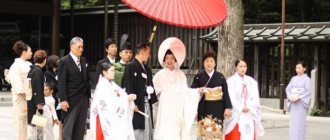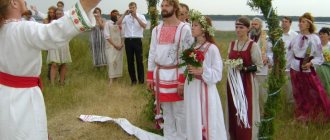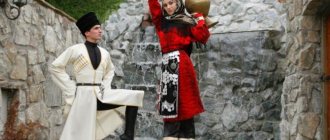One of the small nationalities of the Middle East, living in the foothills of the Caucasus, are the Kabardians. Due to their isolated location and free spirit, they try to preserve their culture, and a Kabardian wedding is a clear demonstration of their customs.
The roots of the traditions according to which the holiday takes place, as well as the rituals preceding it, according to various sources, go back to 2-4 thousand BC. e. Such ancient origins make the whole celebration very unusual and original, which is ideal for newlyweds who want to have a unique wedding.
Family life
The modern life of Kabardians is increasingly changing and urbanizing, but it still retains many traditional features. To a large extent, this is facilitated by the observance of Adyghe Khabze - a moral and ethical code that has been established for centuries, regulating the rules and norms of behavior. It also regulates family relationships.
Family plays a vital role. Politeness and indispensable respect for all family members prevail in relationships. The older generation is given special honor. In the presence of an elder, revered on par with a god, the younger members of the family do not speak first and will never allow themselves to be interrupted. At the table, the elder is given the most honorable place, since age is placed above rank and social status.
Family hierarchy is important, but so are marital ties. According to Kabardian tradition, marriage is possible only once. This is how family values are preserved. Otherwise, they are lost forever. Popular wisdom says: “The husband creates the wife, and the wife creates the husband.” Despite the fact that a woman is in a dependent position with a man, she enjoys honor and respect.
The Kabardian family, the morals and foundations that reign in it, are the main source for the younger generation from which they receive life lessons. Starting from childhood, upbringing in families continues throughout life. Standards of behavior are passed on from generation to generation, and everything is based on the personal example of parents.
What is the republic famous for?
You can come to the republic all year round: there will always be entertainment for the season. Of course, in winter the first place is to relax at ski resorts and climb to the peaks. However, this is not only a winter holiday - there is always snow on Cheget and Elbrus, you just need to climb higher.
In the warm season, mineral waters, mud, climatic resorts, hot springs and pine forests with their healing air are popular in Kabardino-Balkaria. In addition, lovers of hiking, horseback riding, and mountaineering also come here.
Hospitality
A mandatory attribute of any Kabardian home is traditional hospitality, providing every person who crosses the threshold with absolute protection. Even a blood enemy could count on appropriate honors. Receiving a guest at any time, feeding him and settling him in the house is the sacred duty of a Kabardian. Serious fines were imposed for violating the traditions of hospitality or insulting a guest.
In a Kabardian’s house, the guest is completely safe. The best dishes are placed on the table for him, and the best room is allocated - the kunatskaya. The guest usually eats alone; the host can join him only after convincing persuasion. If they are equal in position and age, then they begin the meal together.
According to custom, neither the mistress of the house nor the children sit at the same table with the guest and men. But at the same time, they are nearby, because their help can always be needed. If in cities this tradition has almost been forgotten, in rural areas it is invariably observed.
Story
Balkaria and Kabarda were completely separate regions until 1922. Kabarda became part of the Russian Empire in 1557, while Balkaria only in 1827. Officially, these territories were transferred to our state in 1774 under the Kuchuk-Kainardzhi Treaty.
Kabarda and our country have always been on friendly terms, but they became especially close after Ivan the Terrible married the daughter of the Prince of Kabarda, Temryuk Idarov. In 1561, Goshane became the wife of the Russian ruler, taking the name Maria after baptism. Her brothers went to serve the tsar, founding the family of princes of Cherkasy, who gave Russia many politicians and famous commanders.
In 1944, “thanks to” Stalin, the Balkars were deported. More than 37 thousand people were sent to Central Asia in 14 echelons, among whom were both babies and ancient people. Their only fault was that they were born Balkars. 562 people died on the road. At the end point of the route, carefully guarded barracks were set up for people. For 13 years people actually lived in camps. Leaving without permission was equivalent to escape and was a criminal offense. The story seemed to stop there, since only Kabardians were allowed to remain in the name. Fortunately, in 1957 the Balkars were rehabilitated and the republic returned to its former name.
Since ancient times, Kabardins lived on the plains, while Balkars lived in the mountains. To this day, the situation remains virtually unchanged: the vast majority of villages in the mountains belong to the Balkars. However, the mountaineers are gradually descending into the flat part of the republic. In addition to these two peoples, the republic is inhabited by about ten other nationalities, including Russians.
Wedding
The customs of Kabardians include many interesting rituals. One of the most exciting events is the wedding. Kabardians are in no hurry to decide to get married, approaching this matter very seriously. Often, several months or even years pass between the choice of a future spouse and the wedding day. The wedding ceremony is preceded by the following rituals:
- Matchmaking. The search for a suitable candidate by the groom's relatives takes more than one day. When a worthy bride is found, matchmakers are sent to her house. Sometimes they go several times until consent for marriage is received.
- Agreeing on the amount of dowry. The families of the bride and groom discuss the bride price. Often this conversation is accompanied by disputes, bargaining and lasts until the parties reach a mutual agreement.
- Bride. The meeting of future spouses takes place in the bride's house. On the appointed day, the groom comes to visit, and the betrothal ceremony is held there in accordance with Muslim traditions.
- Payment of part of the dowry. When most of the bride price has been collected, it is given to her relatives. After this, the wedding date is set.
- Taking the bride out of the house. After paying the share of the bride price, the groom has the right to take his bride out. A whole wedding train consisting of the groom's friends usually comes for her. The beautifully dressed bride was released by her relatives under a comic ransom.
- "Hide" in other people's houses. According to the tradition of Kabardians, young people are resettled in other people's (different) houses. From this moment on, communication between the bride and groom stops.
- Moving to the groom's house. The bride is brought to the groom's home secretly. First of all, she inspects the room where she will live, and does not leave it for a whole week. At this time she does not communicate with anyone.
- Rite of reconciliation. The groom's parents reconcile with their daughter-in-law when she emerges from her temporary "imprisonment." After this, a wedding celebration is held, lasting several days.
There are several customs that are strictly observed. The groom is seated at a table with other men, after which they turn off the lights and try to pull off his headdress. The groom should not allow this. For the bride, they spread the skin of a ram on the floor, place the bride on it, and then suddenly try to pull the skin out from under the girl’s feet. The newlywed's task is to maintain balance. After all the tests comes the turn of dancing and showering the newlyweds with millet and coins.
Gradually, customs are lost, and now the most beautiful Kabardian wedding does not include a full set of rituals. The modern interpretation of traditions often comes down to only common elements - traditional outfits, music, singing, parting words. The location of the celebration has changed. If previously it was a home, now the celebration is often celebrated in a cafe/restaurant. A girl has the right to simply return to her parents if she does not want marriage.
Wedding customs
Many interesting Kabardian traditions are associated with marriage. It must be said that the people of Kabardino-Balkaria do not like to show haste, especially on such an important issue. Previously, it was believed that a young man would not be able to choose his future wife correctly, and therefore his parents were engaged in the search. The groom's family collected all available information about the bride candidates by asking relatives.
The girl had to meet the main ideals of the Kabardians, namely, to be modest, hardworking, well-mannered, and healthy. A very important aspect was the possible relationship with the groom's family. It was impossible to allow such a marriage, and therefore all relatives of the brides up to the seventh generation were considered.
After the matchmaking, the bride's parents begin to wonder whether the groom is right for them. Sometimes such reflections drag on for 4-5 months. If all the nuances satisfy both parties, preparations for the wedding begin.
The most important ritual is the removal of the girl from her father's house. This ritual is called “coming off the pillow . After it, the bride and groom settle in different houses in the groom’s yard, and the girl’s relatives receive a bride price.
Kabardians in traditional dresses
Kabardians pay special attention to how the bride crosses the threshold of a new home. This should be done with the right foot, and easily and decisively. Then, as legend says, family life will also be happy and successful. If the bride stumbles on the threshold of a new house, this is considered a bad sign.
It is interesting that researchers consider this tradition to be one of the most ancient in the culture of Kabardians. In the distant past, these people believed that the ashes of their ancestors were located under the threshold. Their spirits protected the house, pointing out to people that they would not bring happiness to the family.
Kabardian wedding
Birth of a child
The customs of the Kabardians regarding the birth of children are very interesting. When a son was born, a red or white flag was hung on the house, and when a daughter was born, a motley flag was hung. A fruit tree was always planted in honor of the baby. This was done by my paternal grandfather.
If a boy was born, this is a joyful event. For the competitive game, smoked cheese and an oiled leather rope were tied to two high posts. Along it, competing men got to the cheese, bit off a piece and received a small prize for it.
Soon after the birth of the baby, “tying into the cradle” was arranged. The baby's cradle was made of hawthorn. According to Kabardian belief, this is a good tree. First, the cat was placed in the cradle so that the child would sleep just as well and peacefully in the future. Two weeks after birth, the baby was also laid down. The ceremony was performed by the paternal grandmother. Sometimes this procedure was entrusted to a familiar woman with many children.
For the baby’s first steps, a special holiday was also held - Lateeuve. The child's legs were tied with a ribbon, then the eldest woman in the family cut it with scissors. This symbolized that in the future nothing would stop the child from moving forward.
Thus, the birth of a child was celebrated as a national holiday - solemnly and magnificently. Both women and men were involved in raising a new member of the community.
Religion
Over the years, Kabardino-Balkaria has become more and more religious. Religion has a positive effect on all areas of the population’s life: for example, there are no drunk or homeless local residents. A woman smoking in rural areas will not only cause confusion, but will also attract comments from residents. Most women wear long skirts and headscarves. In the cities, however, young people are increasingly disregarding these conventions, but you won’t see revealing clothes on the locals here. When traveling to Kabardino-Balkaria, you should take these features into account and not take with you excessively tight outfits or extreme minis.
Atalychestvo
The tradition of atalism is of great interest - a child from an early age was given to be raised in a foster family. With the birth of children in the family, candidates for the role of atalyk lined up. And the richer the family turned out to be, the longer the line was. After some time, the pupil returned to the parental home.
According to Kabardian tradition, in addition to sons, daughters were also raised. In the house of their teacher, they learned everything that could be needed for successful housekeeping. Then they returned to their parents. When the time for marriage arrived, the bride price was given to the atalyk. Attachment to adoptive parents remained for life.
Transport
Major cities are easy to reach, as are tourist spots. Although not often, buses run regularly from Nalchik to all gorges. It is easy to get to any of the resorts by taxi. However, traveling through the passes is only possible in very capable vehicles. A passenger car will only be able to travel in the Baksan Gorge.
Trains can take you to Terek, Nalchik, Maisky and Prokhladny. On the main territory of the republic, the laying of railway tracks is inaccessible due to the terrain.
Interesting customs and signs
Kabardians believed that the well-being of their family depended on the choice of place to build a house. A suitable place was considered to be that piece of land on which any iron objects were found, with dense vegetation and water nearby. The suitability of the place was also checked by the following method: a bucket or cup of milk was left in it overnight. If the amount of milk did not change by morning, the place was considered good. This custom continues to this day.
Kabardians had many different signs associated with houses. The main place of the dwelling was considered to be the hearth, located in the largest room. It was revered as a shrine. A word spoken at the hearth became sacred. It was forbidden to cross the threshold of a house with your left foot, or to run or jump into a house. According to the custom of our ancestors, this brought misfortune. It was also forbidden to greet each other through the window.
The guest was forbidden to touch the broom, which was located in the corner, near the front door. It was considered a bad omen when a broom fell in front of a guest entering the house. Sweeping or throwing away trash at night was not allowed. Passing a knife, sewing needle or other sharp objects with the tip first is also prohibited. You cannot throw the water you were bathing in over the threshold - this was considered a bad omen.
Kabardians also have many customs associated with the burial of the dead. Believing in an afterlife, they made sure that the deceased had everything he needed in the next world. For this purpose, necessary things were depicted on gravestones and monuments. A wake was always held at the guest house. The clothes of the deceased were kept there for a year, turned inside out - this meant that the relative was always expected back.
The traditions and customs of the Kabardians attributed an indifferent attitude towards death. Therefore, on the anniversary of the funeral, they did not mourn for the deceased, but held target shooting competitions, horse races with prizes, and children's competitions.
Republic
First of all, Kabardino-Balkaria, whose religion is an important part of the culture, is known for its highest mountains: most of the world-famous five-thousanders are located on its territory.
The relief increases as you move south - the northern plains gradually rise and bring the traveler to the main Caucasian ridge. It is here, next to Karachay-Cherkessia, that rises Mingi-Tau, known to most under the name Elbrus.
Kabardino-Balkaria, whose religion and language are inextricably linked with the beginning of the history of these peoples, is in no hurry to urbanize. On the territory of the republic there are only 8 cities that remain faithful to the precepts of antiquity. The rest of the population lives in villages and auls located high in the mountains, on the banks of rivers or in gorges. The largest gorges vary greatly in both natural conditions and degree of development. Thus, it is a well-known route for tourists to Cheget and Elbrus. Whereas Khulamo-Bezengiskoe remains a poorly developed area today, accessible only to hikers and climbers. To this day, all gorges have two things in common: stunning, incredible beauty and sheep.
Kabardino-Balkaria, whose religion prohibits the consumption of pork, focuses on sheep farming. Even where human habitation is not visible to the horizon, flocks roam. As soon as thunder thunders, frightening the animals with its echoing rolls, no less piercing cries of sheep are heard in the piercing silence. It makes an incredible impression - the roll call of the elements, the panicky voices of nature. Cows are slightly less popular in the republic. These animals are afraid of little and no matter the disturbances of nature, they still move slowly along the roads, phlegmatically working their jaws.
High in the mountains, with great luck, you can see a real symbol of the Caucasus - mountain aurochs: early in the morning these animals make their way along mountain paths to their grazing places.
The origin of Kabardino-Balkaria suggests a large number of mountain villages, life in which remains unchanged for many centuries. However, after the deportation, despite subsequent rehabilitation, people were not allowed to return to their homes. This is what explains the ruins of villages, through which only the wind blows today.
However, there are still authentic villages in the republic. Even today, everything happens here the same as it did hundreds of years before: elders gather in the central part of the settlement to discuss matters or have a leisurely conversation. Children are running around the streets, women are baking khichina and knitting socks. Centuries-old traditions and everyday life come together here in the most natural way.
Intercession
On October 14, people said goodbye to autumn and welcomed winter. It often snowed on this day, which was compared to the bride’s veil. It is on this day that it is customary to get married, because the Intercession gives love and happiness to all people in love.
There are also special rituals for this holiday. For the first time, women lit a fire in the stove, symbolizing warmth and comfort in the house. Branches or logs of fruit trees had to be used for these purposes. This way it was possible to ensure a good harvest for the next year.
The hostess baked pancakes and Pokrovsky loaf. This bread had to be treated to neighbors, and the leftovers had to be hidden until Lent.
Also on this day one could ask the Mother of God for protection for children. The woman stood with the icon on the bench and read a prayer over her family. All the children knelt down.
Young girls and boys were having get-togethers. It was believed that the Mother of God gave protection to everyone who got married on this day.
You can learn more about all traditions in the Foundations of Religious Cultures and Secular Ethics (ORCSE) training course. The customs and rituals of the Russian people are revealed there with maximum accuracy and described in accordance with historical facts.
National clothes
On ordinary days, national women's clothing included a dress, trousers, a tunic-like shirt, a long swinging dress down to the toes, silver and gold belts and bibs, a cap embroidered with gold, and morocco leggings.
The national men's costume included, as a rule, a Circassian jacket with a stacked silver belt and dagger, a hat, and morocco tunics with leggings; outerwear - burka, sheepskin coat.
The beshmet was girded with the so-called saber girdle, that is, a leather belt decorated with copper and silver plaques, to which a dagger and saber were attached.
Modern traditions of Kabardian weddings
In the scenarios of modern Kabardian weddings, the kidnapping of the bride is considered a mandatory ritual. Relatives received the girl in their house. The parents who came to the chosen one asked her whether she agreed. This did not happen in ancient times. If the answer was yes, then from that moment on the young couple was considered husband and wife. The marriage was necessarily registered by a Muslim priest, an imam, invited to the house.
A beautiful Kabardian wedding, like all other holidays, is celebrated at home. Local residents cannot imagine that it could be organized in some cafe or restaurant. This is explained by the fact that if the girl refuses, she should be able to freely return to her home. This option was not provided in previous years. As soon as the marriage is concluded in compliance with all Muslim traditions, the newlyweds begin to prepare for an exciting celebration.











